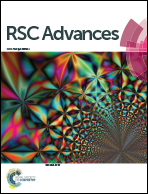Tuning the ballistic electron transport of spatial graphene–metal sandwich electrode on a vacuum-silicon-based device†
Abstract
Future high-speed electronic devices rely on the integration of hot-carrier generation and short transit time. Graphene is an attractive material because of its exceptionally high electron mobility along a 2D honeycomb lattice (in-plane transport). Here, we demonstrate the atomic and electrical interactions of graphene–metal (G–M) and metal–graphene–metal (M–G–M) sandwich electrodes on a vacuum-solid-state-based device (i.e., metal-oxide-Si (MOS) with a void channel) forming G–MOS and M–G–MOS, respectively. The combination of a graphene–metal electrode can produce an extremely high ballistic electron emission (∼106 A cm−2 at 1 V bias), traveling along the vertical direction perpendicular (out of plane) to the graphene mesh. The electron emission process is found to be very robust under low-voltage operation, even for emitters at ambient conditions. In addition, the proposed configurations exhibit electrostatic tuning of ballistic electron transport, governed either by space-charge-limited current or field-emission current, having the potential to significantly contribute to various nanoelectronic applications.



 Please wait while we load your content...
Please wait while we load your content...